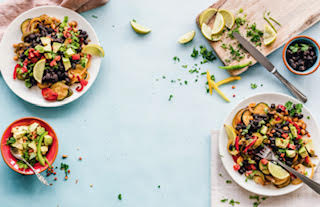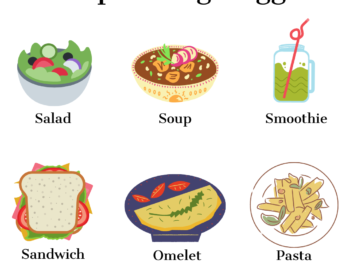Hello,
As a nutritionist, I am a huge fan of salads. After all, colorful veggies are great — chock full of nutrients, antioxidants, and fiber without too many calories. However, not all salads are automatically healthy. Some salads are boring can leave you hungry, like those with just lettuce and tomato, while other salads can be a diet disaster, like those loaded with globs of dressing, cheese, and croutons. With a little thought and advance planning, you can enjoy the perfect salad. Nutritious and delicious!
Here are my top tips to build a delicious–and nutritious–salad entrée.
1. Choose an assortment of deep greens.
Romaine lettuce, kale, and spinach are great choices, high in fiber, folate, and vitamin C. Skip the iceberg lettuce, which is mostly water, and not nearly as many nutrients as the deeper greens. I love a mix of green butter lettuce and red leaf lettuce.
2. Add a mix of colorful non-starchy vegetables.
Adding an assortment of colorful vegetables are your best option, as the different colors impart different nutrients. Throw in some orange veggies such as carrots which are rich in contain beta carotene and add tomatoes which contain lycopene. Other great options are vitamin C-rich yellow and red peppers, broccoli, cucumbers, and mushrooms. You get the idea. It’s okay to throw in the kitchen sink, as they say.
3. Add a healthy protein.
Add grilled salmon, chicken breast, canned tuna, sliced egg, or sliced turkey as a healthy protein option. Aim for around 4 ounces (a little larger than your palm). Grilled tofu or tempeh are great vegan options. Protein is filling and also helps to stabilize blood sugar. Skip the fried chicken, fried fish, and fatty deli meats such as pastrami. And go easy on the cheese.
4. Toss in your favorite beans or legumes.
If you have the urge, toss in some beans or legumes for flavor and added fiber. Chick peas, black beans, kidney beans or lentils are great options. Aim for around 1/2 cup (looks like a cupped hand.) Beans and legumes will add more substance to the salad along with fiber, protein, and nutrients. And they will certainly keep you full. I love roasting chickpeas in the air fryer and tossing them in to my salad–better than croutons!
5. Dress for success.
Salad dressing is high in calories and fat, and we usually get way too much dressing when we order a salad straight off the menu without specifying “light on dressing” or “dressing on the side.” Most restaurant salads contain at least a quarter of cup, or 4 tablespoons of dressing. I suggest asking for dressing on the side, and then you can decide how much to add. It’s also important to watch your portion size when you are home, as a mere tablespoon of oil (while containing heart-healthy fat) contains over 100 calories.
When choosing a dressing, best to pick non-creamy dressings such as balsamic vinaigrette, Italian, or use olive oil and vinegar along with your favorite spices. Go easy on the ranch, Caesar, and blue cheese. And keep the tasteless diet salad dressings on the shelf; often they are lower in fat but higher in sugar making them no healthier than the original versions.
When eating at home, I like to make my own dressing with olive oil, mustard, balsamic vinegar, fresh lemon, and spices. Enjoy 1-2 tablespoons (or a shot glass worth) of dressing. Not a fan of dressing? No problem. Top your salad with some crushed nuts (I like walnuts or sliver almonds) or sliced avocado for a dose of healthy fat.
6. Add some pizazz.
If you want to jazz up your salad a bit, adding some fruit does the trick. I often add pomegranate arils, blueberries, or strawberries to my salad for a little zest. Sliced apple or pear also gives the salad some crunch–and added nutrients. Sometimes I also love to add healthy starch to my salad–especially if it’s a main dish salad. Roasted sweet potatoes are my favorite!
I’d love to hear your favorite salad tips and recipes.
Have a healthy week!
Warmly,
Lisa
Dr. Lisa R. Young
 Enjoy some of my favorite health and wellness AMAZON PICKS.
Enjoy some of my favorite health and wellness AMAZON PICKS.





 Give yourself the gift of wellness
Give yourself the gift of wellness